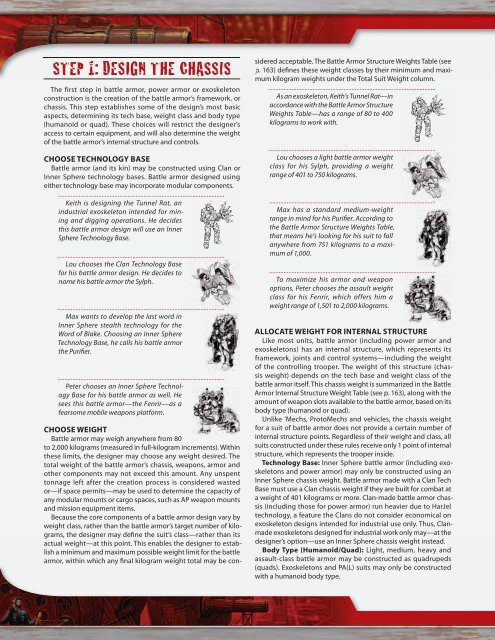the shape of things to come
the shape of things to come
the shape of things to come
Create successful ePaper yourself
Turn your PDF publications into a flip-book with our unique Google optimized e-Paper software.
STEP 1: DESIGN THE CHASSIS<br />
The first step in battle armor, power armor or exoskele<strong>to</strong>n<br />
construction is <strong>the</strong> creation <strong>of</strong> <strong>the</strong> battle armor’s framework, or<br />
chassis. This step establishes some <strong>of</strong> <strong>the</strong> design’s most basic<br />
aspects, determining its tech base, weight class and body type<br />
(humanoid or quad). These choices will restrict <strong>the</strong> designer’s<br />
access <strong>to</strong> certain equipment, and will also determine <strong>the</strong> weight<br />
<strong>of</strong> <strong>the</strong> battle armor’s internal structure and controls.<br />
CHOOSE TECHNOLOGY BASE<br />
Battle armor (and its kin) may be constructed using Clan or<br />
Inner Sphere technology bases. Battle armor designed using<br />
ei<strong>the</strong>r technology base may incorporate modular components.<br />
Keith is designing <strong>the</strong> Tunnel Rat, an<br />
industrial exoskele<strong>to</strong>n intended for mining<br />
and digging operations. He decides<br />
this battle armor design will use an Inner<br />
Sphere Technology Base.<br />
Lou chooses <strong>the</strong> Clan Technology Base<br />
for his battle armor design. He decides <strong>to</strong><br />
name his battle armor <strong>the</strong> Sylph.<br />
Max wants <strong>to</strong> develop <strong>the</strong> last word in<br />
Inner Sphere stealth technology for <strong>the</strong><br />
Word <strong>of</strong> Blake. Choosing an Inner Sphere<br />
Technology Base, he calls his battle armor<br />
<strong>the</strong> Purifi er.<br />
Peter chooses an Inner Sphere Technology<br />
Base for his battle armor as well. He<br />
sees this battle armor—<strong>the</strong> Fenrir—as a<br />
fearsome mobile weapons platform.<br />
CHOOSE WEIGHT<br />
Battle armor may weigh anywhere from 80<br />
<strong>to</strong> 2,000 kilograms (measured in full-kilogram increments). Within<br />
<strong>the</strong>se limits, <strong>the</strong> designer may choose any weight desired. The<br />
<strong>to</strong>tal weight <strong>of</strong> <strong>the</strong> battle armor’s chassis, weapons, armor and<br />
o<strong>the</strong>r components may not exceed this amount. Any unspent<br />
<strong>to</strong>nnage left after <strong>the</strong> creation process is considered wasted<br />
or—if space permits—may be used <strong>to</strong> determine <strong>the</strong> capacity <strong>of</strong><br />
any modular mounts or cargo spaces, such as AP weapon mounts<br />
and mission equipment items.<br />
Because <strong>the</strong> core components <strong>of</strong> a battle armor design vary by<br />
weight class, ra<strong>the</strong>r than <strong>the</strong> battle armor’s target number <strong>of</strong> kilograms,<br />
<strong>the</strong> designer may defi ne <strong>the</strong> suit’s class—ra<strong>the</strong>r than its<br />
actual weight—at this point. This enables <strong>the</strong> designer <strong>to</strong> establish<br />
a minimum and maximum possible weight limit for <strong>the</strong> battle<br />
armor, within which any fi nal kilogram weight <strong>to</strong>tal may be con-<br />
sidered acceptable. The Battle Armor Structure Weights Table (see<br />
p. 163) defi nes <strong>the</strong>se weight classes by <strong>the</strong>ir minimum and maximum<br />
kilogram weights under <strong>the</strong> Total Suit Weight column.<br />
As an exoskele<strong>to</strong>n, Keith’s Tunnel Rat—in<br />
accordance with <strong>the</strong> Battle Armor Structure<br />
Weights Table—has a range <strong>of</strong> 80 <strong>to</strong> 400<br />
kilograms <strong>to</strong> work with.<br />
Lou chooses a light battle armor weight<br />
class for his Sylph, providing a weight<br />
range <strong>of</strong> 401 <strong>to</strong> 750 kilograms.<br />
Max has a standard medium-weight<br />
range in mind for his Purifi er. According <strong>to</strong><br />
<strong>the</strong> Battle Armor Structure Weights Table,<br />
that means he’s looking for his suit <strong>to</strong> fall<br />
anywhere from 751 kilograms <strong>to</strong> a maximum<br />
<strong>of</strong> 1,000.<br />
To maximize his armor and weapon<br />
options, Peter chooses <strong>the</strong> assault weight<br />
class for his Fenrir, which <strong>of</strong>fers him a<br />
weight range <strong>of</strong> 1,501 <strong>to</strong> 2,000 kilograms.<br />
ALLOCATE WEIGHT FOR INTERNAL STRUCTURE<br />
Like most units, battle armor (including power armor and<br />
exoskele<strong>to</strong>ns) has an internal structure, which represents its<br />
framework, joints and control systems—including <strong>the</strong> weight<br />
<strong>of</strong> <strong>the</strong> controlling trooper. The weight <strong>of</strong> this structure (chassis<br />
weight) depends on <strong>the</strong> tech base and weight class <strong>of</strong> <strong>the</strong><br />
battle armor itself. This chassis weight is summarized in <strong>the</strong> Battle<br />
Armor Internal Structure Weight Table (see p. 163), along with <strong>the</strong><br />
amount <strong>of</strong> weapon slots available <strong>to</strong> <strong>the</strong> battle armor, based on its<br />
body type (humanoid or quad).<br />
Unlike ’Mechs, Pro<strong>to</strong>Mechs and vehicles, <strong>the</strong> chassis weight<br />
for a suit <strong>of</strong> battle armor does not provide a certain number <strong>of</strong><br />
internal structure points. Regardless <strong>of</strong> <strong>the</strong>ir weight and class, all<br />
suits constructed under <strong>the</strong>se rules receive only 1 point <strong>of</strong> internal<br />
structure, which represents <strong>the</strong> trooper inside.<br />
Technology Base: Inner Sphere battle armor (including exoskele<strong>to</strong>ns<br />
and power armor) may only be constructed using an<br />
Inner Sphere chassis weight. Battle armor made with a Clan Tech<br />
Base must use a Clan chassis weight if <strong>the</strong>y are built for combat at<br />
a weight <strong>of</strong> 401 kilograms or more. Clan-made battle armor chassis<br />
(including those for power armor) run heavier due <strong>to</strong> HarJel<br />
technology, a feature <strong>the</strong> Clans do not consider economical on<br />
exoskele<strong>to</strong>n designs intended for industrial use only. Thus, Clanmade<br />
exoskele<strong>to</strong>ns designed for industrial work only may—at <strong>the</strong><br />
designer’s option—use an Inner Sphere chassis weight instead.<br />
Body Type (Humanoid/Quad): Light, medium, heavy and<br />
assault-class battle armor may be constructed as quadrupeds<br />
(quads). Exoskele<strong>to</strong>ns and PA(L) suits may only be constructed<br />
with a humanoid body type.


